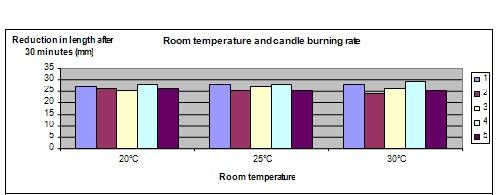| Complexity level: | 5 |
| Project cost ($): | 10 |
| Time required: | 1 hour to prepare, 4 hours for observation |
| Material availability: | Easily found |
| Safety concerns: | Take the necessary precautions when handling fire. Ensure that no flammable materials are placed near the candles during the experiment. Adult supervision required. |
Hypothesis
A candle in a colder room will burn more slowly.
Overview
Candles
Candles are used to provide light when there is no electricity available or during power failures. Candles are also used to create a romantic setting at restaurants. Most candles are made of paraffin wax. Candles are also made from other types of materials such as soy wax, bee wax, plant wax or animal fat. The wax in a candle is used as fuel to keep the candle burning.
The wick used in a candle is an absorbent twine and must have strong capillary action. When the wick is lit, the wax around the wick will melt due to the heat of the flame. The capillary action of the wick will absorb the melted wax and pull it upwards. When the wax is exposed to the flame, it will vaporize and the wax vapor burns. The wick does not burn as quickly, because the vaporizing wax will help to cool the temperature of the wick and protect it.
Candles are manufactured in various sizes, scents and colors. Some of the scents used in candles include flower scents, fruit scents, vanilla and even green tea. These scented candles are used in aromatherapy and spas. Candles are also used in religious ceremonies and of course, what's a birthday cake without candles?
Scientific Terms
Materials
The materials required for this science fair project:
- 15 candles. The candles should be of the same diameter, length and be made by the same manufacturer
- A ruler
- A caliper
- A stopwatch
- A match box or lighter
- A room with air-conditioning (preferably reverse-cycle)
- A heater (if reverse-cyle air-conditioning is not avaiable)
- A thermometer
Procedure
1. For this science fair project, the independent variable is the temperature of the room, i.e. 20°C, 25°C and 30°C. The dependent variable is the length of the candle after it has burned for 30 minutes. This is determined by measuring the length of each candle with a ruler before it is lit and after it has burned for 30 minutes. The constants (control variables) are the type and length of the candle, the diameter of the candle and the time the candle is allowed to burn.
2. Using the ruler and caliper, the length and the diameter of the 15 candles are measured for consistency. If the measurement of a candle deviates by more than 1 millimeter from the average, have that candle replaced. All 15 chosen candles are labeled as “A1” to “A5”, “B1” to “B”5 and “C1” to “C5” respectively. The length of the 15 candles is measured and recorded.
3. The air conditioner in the room is switched on and the room is left to is cool, until the room temperature measures 20°C. The temperature of the room is verified with the thermometer. The candles marked “A1” to “A5” are lit in the room and the stopwatch is started. Ensure that windows are closed and the candles are not placed anywhere near the air-conditioner blower (avoid drafts). After 30 minutes, the flames on the candles are extinguished and the length of each candle is measured again with a ruler. The reduction in candle length is calculated and recorded in the table shown below. You may need to air the room to get rid of the candle smoke, before proceeding to step 4.
4. The air conditioner is switched off and the room temperature is allowed to rise to 25°C. You may need to turn on the heater to achieve this temperature. The temperature of the room is verified with the thermometer . Procedure 3 is repeated using the candles marked “B1” to “B5”. The reduction in candle length after 30 minutes is calculated and recorded in the table shown below. You may need to air the room to get rid of the candle smoke, before proceeding to step 5.
5. The heater is turned on in the room until the room temperature reaches 30°C. The temperature of the room is verified with the thermometer. Procedure 3 is repeated with candles marked “C1” to “C5” and the reduction in the candle length after 30 minutes is calculated and the results recorded. in the table below.

Results
The length of the burnt away in 30 minutes is almost the same at all 3 different room temperatures.
| Room temperature | Average length of candle burnt in 30 minutes (mm) | ||||
| 1 | 2 | 3 | 4 | 5 | |
| 20°C | 27 | 26 | 25 | 28 | 26 |
| 25°C | 28 | 25 | 27 | 28 | 25 |
| 30°C | 28 | 24 | 26 | 29 | 25 |
The graph below represents the results of our science experiment:

Conclusion
The hypothesis that a candle in a colder room will burn more gradually/slowly is disproved. All of the candles burned at almost the same rate regardless of the surrounding temperature.
Also consider
This science fair project can also be varied to compare the burn rate of candles made from different materials like soy wax or animal fat.
Try to repeat the experiment to compare the weight of the candle instead of the length. Would there be a difference?
What if the room temperature were to be varied more significantly? Eg. Measuring burn-rate at 5 degrees, 20 degrees and 40 degrees?
References
Candle - http://en.wikipedia.org/wiki/Candle
How does a candle work? - http://home.howstuffworks.com/question267.htm

